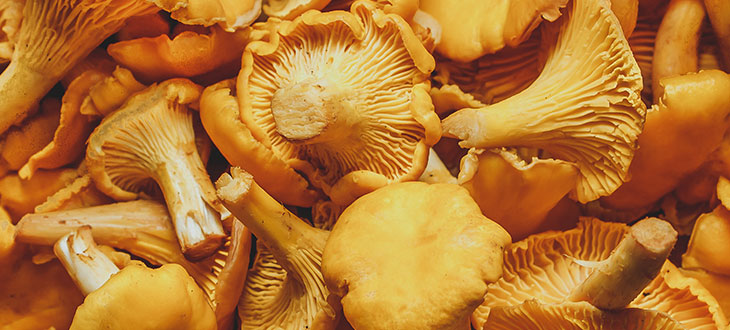10 Yellow Mushroom Species
Did you find yellow mushrooms in the pots of your houseplants, in the garden, yard, or in the forest? We made a list of 10 species of yellow mushrooms to help you identify them.
Fungi (mushrooms) form one of the kingdoms of eukaryotes (organisms whose cells have a nucleus contained within a nuclear membrane).
Fungi are sedentary, similar to plants, but they are considered more closely related to animals than to plants. They do not perform photosynthesis and have to feed like animals, by assimilating organic substances from the environment.
No one knows exactly how many species of mushrooms are in nature, but sources say that if you include molds and yeasts, there are more than 50.000 different types.
The world of mushrooms is truly fascinating due to their variety both in terms of shape, size, and color. We can find mushrooms with colors like white, yellow, orange, red, green, pink, and many other combinations and shades.
However, today we will classify mushrooms according to their color. More precisely, we made a list of mushroom species that have a predominantly yellow color.
Before we begin, we want to explicitly specify that information on the toxicity of each species of mushroom is extracted from various sources. This information may or may not be correct. The role of this article is not to advise you whether these species of fungi are poisonous or not, but it is meant to give you a starting point to identify more easily the many types of yellow fungi.
Never consume mushrooms that you cannot identify accurately and which you do not know for sure that they are not poisonous. Just because a species of mushroom is labeled as “Non-Toxic” or “Non-Poisonous,” that doesn’t necessarily mean it is edible and safe for consumption.
Also, we want to specify that the author of this article is not a mycologist. Therefore, he or the owners of this website cannot be held responsible for the eventual errors in the identification of the mushroom species in each photo.
Below are several species of mushrooms that stand out due to their yellow or golden color.
Contents
- 1. Flowerpot parasol (Leucocoprinus birnbaumii)
- 2. Golden Oyster Mushroom (Pleurotus citrinopileatus)
- 3. Chicken Of The Woods (Laetiporus sulphureus)
- 4. Golden Chanterelle (Cantharellus cibarius)
- 5. Jack-O-Lantern Mushroom (Omphalotus olearius)
- 6. Witch’s butter (Tremella mesenterica)
- 7. Yellow Patches (Amanita flavoconia)
- 8. Golden Spindles (Clavulinopsis fusiformis)
- 9. Golden Ear (Tremella aurantia)
- 10. Golden Waxcap (Hygrocybe chlorophana)
1. Flowerpot parasol (Leucocoprinus birnbaumii)
| Scientific Name | Leucocoprinus birnbaumii |
| Common Name | Flowerpot parasol, Plantpot dapperlings |
| Family | Agaricaceae |
| Toxicity | Toxic |
Flowerpot parasols are yellow mushrooms that often emerge in flowerpots and greenhouses.

Leucocoprinus birnbaumii it is naturally found in areas with tropical and subtropical climates, but was also brought in many other parts of the world through the imports of exotic plants that carried spores of this fungus in their soil.
Leucocoprinus birnbaumii is one of the most common mushrooms of potted plants. That’s why it also got the name “flowerpot parasol” or “plantpot dapperlings.”
Fruit bodies of flowerpot parasols have a bright pale sulfur-yellow color and even though they can occur individually, most of the time, they appear in small clusters.
Leucocoprinus birnbaumii is a saprotroph mushroom. It doesn’t hurt nearby plants and doesn’t steal their nutrients. It is actually beneficial to the environment as it feeds on rotten organic matter from the humus and compost and helps the carbon, nitrogen, and minerals to get into a form that plants and other living organisms can use.
So, if the yellow of this mushroom does not bother you too much when it appears in the pot of your plants, you can just leave it there, because it will not harm the growth of the plants.
However, keep in mind that Leucocoprinus birnbaumii is rated as poisonous. Hence, if you have small children or pets, it is better to remove these mushrooms and avoid any potential risks.
2. Golden Oyster Mushroom (Pleurotus citrinopileatus)
| Scientific Name | Pleurotus citrinopileatus |
| Common Name | Golden oyster mushroom |
| Family | Pleurotaceae |
| Toxicity | Non-Toxic |
The golden oyster mushroom is one of the most popular wild edible mushrooms. They are native to Japan, northern China, and eastern Russia. They are popularly called “oyster mushrooms” because of their appearance that resembles very much oysters.
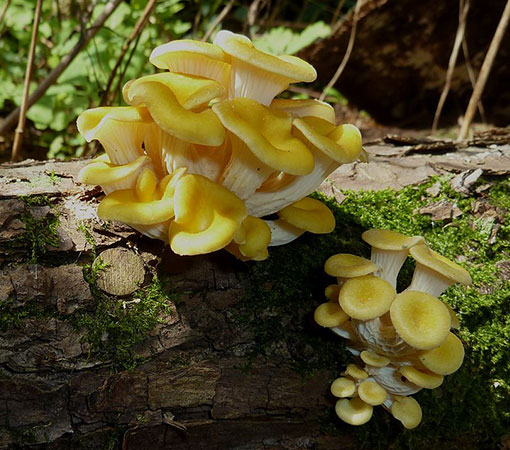
Besides being found in nature, they are also one of the species of mushrooms that are cultivated for production in several countries.
Pleurotus citrinopileatus is a saprophytic fungus that feeds mostly on decaying hardwood. In the wild, they usually develop in clumps and usually grow on the trunks of fallen trees. Due to their bright golden-yellow color, they are usually easily visible from afar.
You should be careful though when you find these species in the wild as there are several other species of poisonous mushrooms that look pretty similar to the golden oysters.
One toxic example is the western jack-o’-lantern mushroom (omphalotus olivascens), which is an orange to brown-colored mushroom native to California and Mexico.
3. Chicken Of The Woods (Laetiporus sulphureus)
| Scientific Name | Laetiporus sulphureus |
| Common Name | Chicken Of The Woods |
| Family | Fomitopsidaceae |
| Toxicity | Non-Toxic |
Laetiporus sulphureus is a polypore fungus that grows on trees (most commonly on oak trees) and is native to Europe and North America. It is known under several names, such as chicken of the woods, chicken mushroom, crab of the woods, sulphur shelf, and sulphur polypore.

This mushroom has earned the name “chicken of the woods” because many describe it as having the taste of chicken meat.
Chicken of the woods is mostly a saprophyte mushroom that lives on the dead or rotting organic matter but occasionally can grow as parasite fungus on living trees.
The fruiting bodies of this mushroom can be extremely large and have a strident sulfur-yellow to orange color with a fan-shaped shelf structure.
This mushroom is only edible when young and only when cooked. Specialists warn that it can become toxic when growing on particular species of trees.
Besides its shelf-like appearance and strident yellow color, other essential characteristics for identifying chicken of the woods mushrooms lay on the underside. Unlike other look-alike varieties, on the inferior side laetiporus sulphureus is yellow and does not have gills or ridges, but very tiny microscopic pores.
4. Golden Chanterelle (Cantharellus cibarius)
| Scientific Name | Cantharellus cibarius |
| Common Name | Golden Chanterelle |
| Family | Cantharellaceae |
| Toxicity | Non-Toxic |
Cantharellus cibarius is a variety of golden chanterelle mushrooms, in the genus Cantharellus.

Golden Chanterelles are some of the most common edible mushrooms found in nature. They can be seen in the coniferous and deciduous forests of Europe from Scandinavia to the Mediterranean Basin.
Chanterelles are mycorrhizal mushrooms. Mycorrhizal fungi form a connection with plant roots and with the soil, helping the plant to accumulate nutrients and water from the soil in exchange for sugars resulted after photosynthesis.
Cantharellus cibarius is easy to distinguish due to its yellow color and particularities. These mushrooms have a smooth cap with forked ridges on their underside which go down the stem. They also have curled edges which differentiates them from similar species.
In many regions, these mushrooms emerge during summer while in others, chanterelles fruit in the autumn.
Golden chanterelles are very appreciated in many kitchens due to their special flavor and texture. Many describe the taste of chanterelles as fruity and similar to ripen apricots.
Watch out for the Jack-O-Lantern mushrooms (Omphalotus olearius) if you pick up these mushrooms from the wild. Jack-O-Lantern looks pretty similar to chanterelles and is poisonous.
Golden chanterelle can also easily be mistaken for Hygrophoropsis aurantiaca, which is also known as the false chanterelle.
5. Jack-O-Lantern Mushroom (Omphalotus olearius)
| Scientific Name | Omphalotus olearius, Omphalotus illudens |
| Common Name | Jack-O-Lantern Mushroom |
| Family | Marasmiaceae |
| Toxicity | Poisonous |
The Jack-O-Lantern is a late-summer-to-fall species of mushrooms that can be found in woodland areas of Europe and eastern North America. They tend to grow in large clusters.
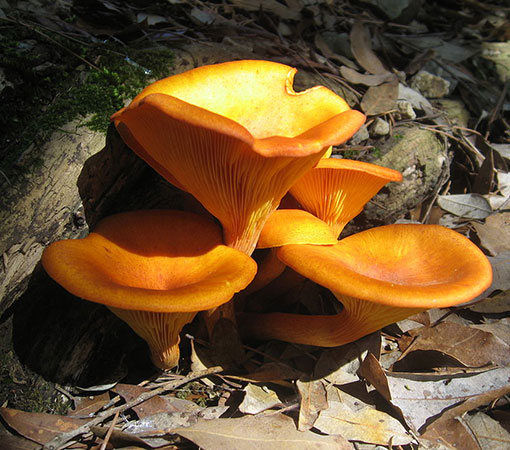
The fruiting body of this fungus has a yellow-to-orange color and grows in clusters on decaying stumps, on buried roots, or at the base of some species of trees. These mushrooms have true, sharp, non-forking gills.
Although Jack-O-Lantern mushrooms have a pleasant odor and appearance they are poisonous. They can be easily mistaken with chanterelle mushrooms, which are edible and which many gather for consumption.
This mushroom has earned the name Jack-O-Lantern not only because it has an orange color similar to pumpkins and because it usually appears during Halloween, but also due to its special bioluminescence properties.

As weird as it sounds, this mushroom can glow in the dark. More precisely, its gills emit a greenish light in low light conditions due to an enzyme called luciferase.
6. Witch’s butter (Tremella mesenterica)
| Scientific Name | Tremella mesenterica |
| Common Name | Witch’s butter, Yellow brain, Golden jelly fungus, Yellow trembler |
| Family | Tremellaceae |
| Toxicity | Non-toxic |
Tremella mesenterica is a jelly fungus. Its fruiting body has an irregular shape and consists of a gelatinous orange-yellow mass that has a lobed surface and which is oily or slimy when moist. When dries, these turn to an orange or dark reddish color.
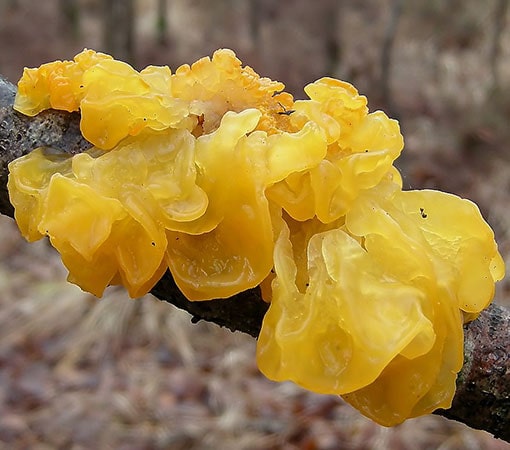
It grows in temperate and tropical regions that include North, and South America, Europe, Africa, Asia, and Australia and can be seen in deciduous and mixed forests.
Due to its strange appearance and characteristics, this fungus has earned the name “witch’s butter” but is also commonly known as the yellow brain, yellow trembler, or golden jelly fungus.
Although apparently witch’s butter grows on dead wood, it is actually a parasite of another wood-decomposing fungus.
Unlike many mushrooms that only produce fruiting bodies in a particular season, tremella mesenterica develops fruiting bodies along the year, typically after rains, and throughout wet periods.
Despite its weird looks, witch’s butter is considered non-poisonous and generally edible but it is far from being deemed a delicacy. Many describe this fungus as flavorless.
7. Yellow Patches (Amanita flavoconia)
| Scientific Name | Amanita flavoconia |
| Common Name | Yellow patches, Orange amanita, Yellow wart, Yellow-dust amanita |
| Family | Amanitaceae |
| Toxicity | Poisonous |
Amanita flavoconia is a mushroom that has a yellow-to-orange cap with yellowish-orange warts or patches and a white-to-orange stem. It grows on the forest floors of broad-leaved and mixed forests in eastern North America.
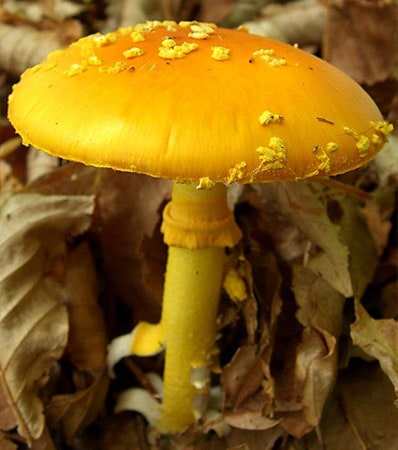
This fungus is part of the Amanitaceae family, a group that includes some of the most poisonous species of mushrooms in the world.
Because of its bright color and particularities, Amanita flavoconia is typically easy to find and recognize. It can sometimes be confused with Amanita frostiana, which is another mushroom with similar characteristics and colors from the same family. However, both species are considered inedible and poisonous.
This mushroom emerges with a cap that is initially egg-shaped, but while it matures, it becomes curved and eventually flattens. Under the cap, Amanita flavoconia has white or tinged yellow gills that are squeezed close together, almost free from the stalk, and originally covered with a yellowish partial veil.
The young specimens of amanita flavoconia are usually surfaced with chrome yellow spots, hence, its name “yellow patches.” These can be easily washed away by rain or wiped off.
Amanita flavoconia is generally considered a highly toxic species of mushrooms and can be deadly if ingested.
8. Golden Spindles (Clavulinopsis fusiformis)
| Scientific Name | Clavulinopsis fusiformis |
| Common Name | Golden spindles, Spindle-shaped yellow coral, Spindle-shaped fairy club |
| Family | Clavariaceae |
| Toxicity | Non-Toxic |
Clavulinopsis fusiformis is a species of coral fungus in the family Clavariaceae and is widely distributed in Asia, Europe, and North America. It is popularly known as golden spindles, spindle-shaped fairy club, or spindle-shaped yellow coral.
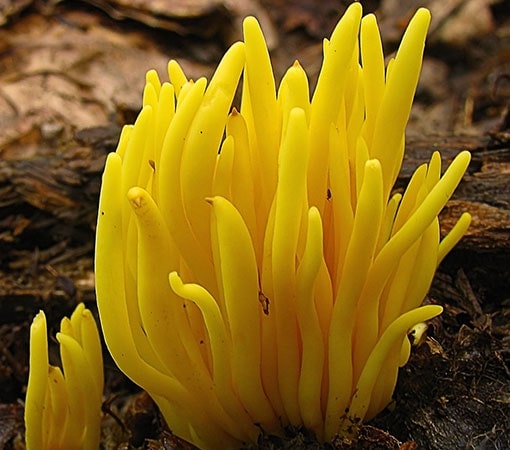
Golden Spindle is a saprobic species that feeds with decaying wood and which commonly grows on the floor of woodland areas, mostly under conifers or hardwoods, and in areas covered with grass and around mosses.
These fungi have bright yellow, slim, and elongated cylindrical and unbranched fruiting bodies that grow in dense clusters. These mostly resemble corals, hence the name “spindle-shaped yellow coral.”
Although there are several other coral species of fungi with similar features, due to their shape, color, and way of growing, clavulinopsis fusiformis is pretty easy to identify.
Clavulinopsis fusiformis is generally considered not-poisonous mushrooms, but various guides label it as both edible and inedible.
9. Golden Ear (Tremella aurantia)
| Scientific Name | Tremella aurantia |
| Common Name | Golden Ear |
| Family | Tremellaceae |
| Toxicity | Non-Toxic |

Tremella aurantia is a species of jelly fungus that is found in various parts of Europe and North America and is commonly known as the “golden ear” due to its looks.
This fungus is very similar in appearance to witch’s butter and is often mistaken for it. Both of them are parasitic on other fungi, have a yellow-to-orange curly fruiting body, develop on hardwoods, and are comparable in size.
One of the main differences between these two is that witch’s butter typically parasites fungi in the genus of Peniophora, while golden ear grows on Stereum hirsutum, commonly known as the false turkey tail.
Tremella aurantia typically makes its appearance in late summer and during the fall, after rainy periods. In the lack of enough moist, tremella aurantia receives an orange color and becomes a hard crust.
Although tremella aurantia is labeled as non-poisonous by many sources, due to the lack of enough information on this particular species, it is uncertain whether this mushroom safe to eat or not.
10. Golden Waxcap (Hygrocybe chlorophana)
| Scientific Name | Hygrocybe chlorophana |
| Common Name | Golden Waxcap |
| Family | Hygrophoraceae |
| Toxicity | Non-Toxic |
Hygrocybe chlorophana, or golden waxcap, as it is generally known, is a species of tiny and yellow mushrooms that grow in grassland and woodland regions in Europe, North America, and isolated, in the southern mountainous areas of Australia.
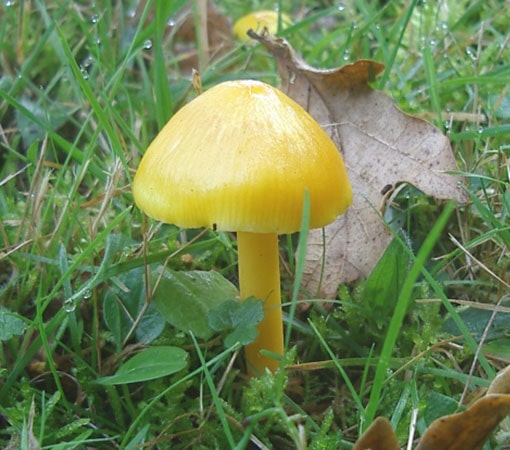
Hygrocybe chlorophana got the name “waxcap” because of its yellow cap that is always moist and looks like has been covered in wax. On the underside, it has broad and fairly spaced gills.
The Hygrocybe genus includes several species of waxcap mushrooms, but not all of them are yellow. Some varieties are red (scarlet waxcap), green (parrot waxcap), pink (pink waxcap), black (witch’s hat), or combinations of orange, yellow, and red.
These fungi usually appear in the fall and usually grow in small groups. Golden waxcaps are not mushrooms that grow very large and usually do not exceed 4 cm in diameter.
Although the golden waxcaps are generally considered non-toxic, they are far from being a popular choice for dishes. These mushrooms do not have an impressive taste, are pretty rare, small, and do not grow in large groups.
Final Word
These are 10 of the most popular species of yellow mushrooms.
I hope you’ll find this article helpful, and the next time you come across one of these varieties of mushrooms, you will be able to easily identify it.
Since you have reached the end of the article, you may also be interested in our selection of 10 red mushroom species.
Please do not eat any species of mushrooms based only on the information presented in this article! Always consult a specialist before determining whether a mushroom is safe for consumption or not.

